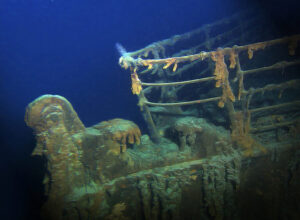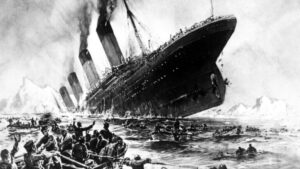The Titanic’s Missing Bodies: A Haunting Mystery of the Deep
The RMS Titanic’s tragic sinking on April 15, 1912, remains one of the most captivating and devastating stories in history, continuing to fascinate the world over a century later. On its maiden voyage from Southampton to New York, the “unsinkable” ship struck an iceberg, resulting in the loss of more than 1,500 passengers and crew. But beyond the shock of the disaster itself, one eerie mystery has persisted: Why were so few bodies recovered from the wreckage, despite the overwhelming loss of life?
The Discovery of the Titanic Wreck
It wasn’t until September 1, 1985, that the Titanic wreckage was discovered, over 12,000 feet beneath the surface of the North Atlantic. After decades of speculation and failed expeditions, a team led by deep-sea explorer Robert Ballard finally located the ship. Using his method of following debris, which he had previously used to locate the Scorpion, a nuclear submarine that sank in 1968, Ballard was able to pinpoint the Titanic’s resting place 400 miles off the coast of Newfoundland, Canada.
Though the location of the wreck had been known in general terms, finding the exact spot proved to be a massive challenge. Ballard’s expedition lasted eight days before he made his discovery. He was overcome with emotion when he first laid eyes on the Titanic’s remains, telling CBS News, “We made a promise to never take anything from that ship, and to treat it with great respect.” Since then, various teams have recovered hundreds of artifacts from the wreck, offering a window into the ship’s opulent past. Items like furniture, dinnerware, and personal belongings of the lost passengers have provided a sense of connection to those who never made it off the doomed vessel.
However, something was noticeably absent from the wreck site—human remains. This stark omission has left many wondering what happened to the bodies of the Titanic’s victims.

Where Are the Bodies?
Upon discovering the wreck, researchers found the Titanic split in two, with the bow remaining relatively intact, showing remarkably preserved interiors for a ship that had been underwater for over 70 years. Surrounding the wreckage was a vast debris field, stretching five miles long and three miles wide, littered with thousands of objects scattered across the ocean floor. But the one thing conspicuously missing was the bodies of the passengers and crew who had perished.
While shoes, boots, and personal effects were found among the debris, human remains were few and far between. Out of the 337 bodies that were recovered after the sinking, 119 were buried at sea, and the remaining 209 were returned to Halifax for burial. Despite repeated expeditions, including 33 trips made by director James Cameron, who famously explored the wreck, no human remains have ever been discovered at the site. Cameron himself stated, “I’ve seen zero human remains. We’ve seen clothing, pairs of shoes, which would strongly suggest there was a body there at one point. But we’ve never seen any human remains.”
So, what happened to all those who perished in the disaster?
The Role of the Ocean Depths
The truth seems to lie in the extreme conditions surrounding the wreck. The Titanic now rests at a staggering depth of over 12,000 feet, where the water temperature hovers just above freezing and the pressure is immense. These factors have contributed to the bodies disappearing over time, primarily due to the work of bacteria and sea creatures that thrive in the depths of the ocean.
As Ballard explains, the cold temperatures and deep-sea environment create conditions that speed up the decomposition process. Soft tissues are consumed by bacteria and marine creatures, leaving little behind. What remains are items like boots and shoes, which are not as easily consumed by sea life.
The Dissolution of Bones
But it’s not just marine life that plays a role in the disappearance of bodies. According to Robert Ballard, the seawater at these depths also has an extraordinary ability to dissolve bones. The water is under-saturated in calcium carbonate, a substance that forms the primary component of bones. When the soft tissue is eaten away, the bones themselves gradually dissolve in the deep ocean, leaving no trace behind.
Ballard compares this phenomenon to what happens in the Black Sea, where bodies can mummify due to the lack of marine life that can break them down. In contrast, at depths like those where the Titanic rests, the bones of the deceased vanish into the water’s depths, consumed by nature.
“Below about 3,000 feet [914 meters], you pass what’s called the calcium carbonate compensation depth,” Ballard explained in an interview with NPR. “Once critters eat the flesh and expose the bones, the bones dissolve.” The Titanic’s wreck, lying below this threshold, has left no skeletal remains to be discovered, a haunting reminder of the harshness of the deep ocean.

A Haunting Reality
The disappearance of the Titanic’s victims’ bodies has captivated the public’s imagination, with many describing it as eerie or even horrifying to consider the vast loss of life and the ultimate fate of those lost at sea. Some find solace in the fact that nature reclaimed the bodies in its own way, with one online commenter noting, “The only comfort is that those victims were given back to nature the only way Mother Nature knows how.”
Despite this comfort, the wreckage of the Titanic continues to decay slowly. In recent years, bacteria that feed on iron have begun to erode the ship’s structure. Scientists predict that in the next 50 years, the Titanic could collapse completely, leaving only rust and the remnants of its once-majestic interior behind.
A Modern Tragedy
In 2023, the Titanic’s wreckage became the site of another tragedy. The Titan submersible, operated by OceanGate, imploded during a tourist expedition, killing all six passengers onboard. Among the victims was Stockton Rush, the pilot of the sub, and Paul-Henri Nargeolet, a Titanic expert, as well as three tourists. The tragedy added yet another layer of sorrow to the Titanic’s legacy, underscoring the risks involved in visiting the final resting place of the legendary ship.
While the mystery of the missing bodies of Titanic’s victims may never be fully resolved, it remains a reminder of nature’s unrelenting power and the unimaginable scale of the loss that occurred on that fateful night. The wreck continues to stand as a silent monument to the thousands who perished, their bodies claimed by the ocean, leaving only the ship and its tragic story to tell the tale.




